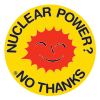
Back Antiatombewegung in Australien German Mouvement antinucléaire en Australie French Anti-nuclear movement in Australia SIMPLE

Nuclear weapons testing, uranium mining and export, and nuclear power have often been the subject of public debate in Australia, and the anti-nuclear movement in Australia has a long history. Its origins date back to the 1972–1973 debate over French nuclear testing in the Pacific and the 1976–1977 debate about uranium mining in Australia.[4][5]
Several groups specifically concerned with nuclear issues were established in the mid-1970s, including the Movement Against Uranium Mining and Campaign Against Nuclear Energy (CANE), cooperating with other environmental groups such as Friends of the Earth and the Australian Conservation Foundation.[6][7][8][9] The movement suffered a setback in 1983 when the newly elected Labor Government failed to implement its stated policy of stopping uranium mining.[10] But by the late 1980s, the price of uranium had fallen, the costs of nuclear power had risen, and the anti-nuclear movement seemed to have won its case; CANE was disbanded in 1988.[11]
As of 2015, Australia has no nuclear power stations and five uranium mines, four of which are located in South Australia. Olympic Dam (Roxby Downs) is a large underground mine, Beverley, Four Mile and Honeymoon are in-situ leach mines and Ranger is an open pit mine in the Northern Territory.[12] As of 2021 only two mines are operating (Olympic Dam and Four Mile) following the closure of Beverley and Ranger and the placement of Honeymoon into care-and-maintenance. Uranium mined in Australia is mainly for export. Australia has no nuclear weapons or nuclear-powered vessels.
| Anti-nuclear movement |
|---|
 |
| By country |
| Lists |
- ^ "Welcome". Radium Hill Historical Association. Archived from the original on 12 June 2009. Retrieved 27 July 2009.
- ^ "Radium Hill, SA". www.sea-us.org.au. Archived from the original on 13 September 2009. Retrieved 27 July 2009.
- ^ "Australia's Uranium and Nuclear Power Prospects". World Nuclear Association. April 2009. Archived from the original on 2 November 2019. Retrieved 24 July 2009.
- ^ Green, Jim (26 August 1998). Australia's anti-nuclear movement: a short history Archived 5 April 2008 at the Wayback Machine Green Left Online. Retrieved 15 December 2010.
- ^ Koutsoukis, Jason (25 November 2007). Rudd romps to historic win Archived 23 October 2012 at the Wayback Machine The Age. Retrieved 15 December 2010.
- ^ McLeod, Roy (1995). "Resistance to Nuclear Technology: Optimists, Opportunists and Opposition in Australian Nuclear History" in Martin Bauer (ed) Resistance to New Technology, Cambridge University Press, pp. 171–173.
- ^ Cite error: The named reference
Huttonwas invoked but never defined (see the help page). - ^ Kearns, Barbara (2001). "Stepping out for peace : a history of CANE and PND (WA)". Commons Social Change Library. Archived from the original on 27 January 2023. Retrieved 30 May 2022.
- ^ Branagan, Marty (2014). "he Australian Movement against Uranium Mining: Its Rationale and Evolution". The Commons Social Change Library. Archived from the original on 30 May 2022. Retrieved 30 May 2022.
- ^ Friends of the Earth (Canberra) (January 1984). Strategy against nuclear power
- ^ McLeod, Roy (1995). "Resistance to Nuclear Technology: Optimists, Opportunists and Opposition in Australian Nuclear History" in Martin Bauer (ed) Resistance to New Technology, Cambridge University Press, pp. 175–177.
- ^ Work begins on Honeymoon uranium mine Archived 27 April 2009 at the Wayback Machine (24 April 2009), ABC News. Retrieved 15 December 2010.